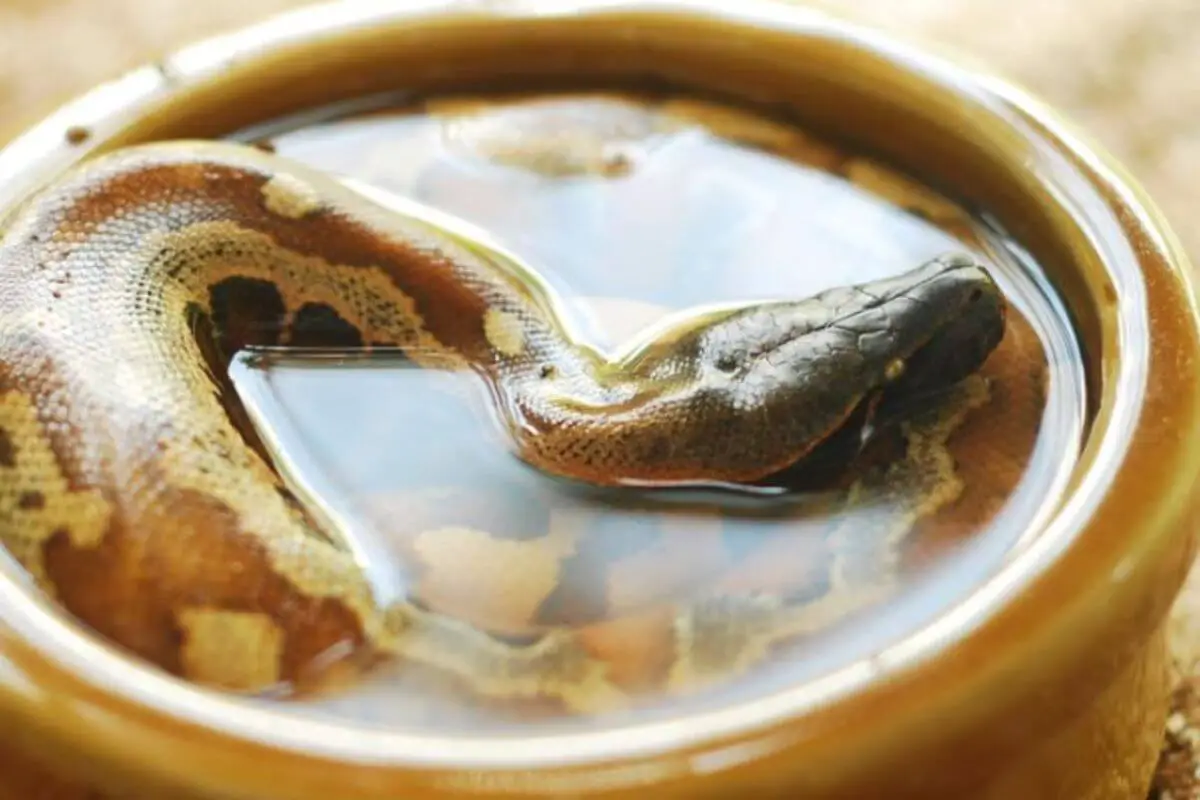Bathing a snake might seem like an unusual task, but it’s a crucial aspect of reptile care. Snakes, like any other pets, benefit from proper hygiene to maintain their health and vitality. Whether you’re a seasoned reptile enthusiast or a new snake owner, let’s embark on a comprehensive guide on how to give your slithery companion a bath with confidence and care.
**1. Understanding the Why: The Importance of Snake Bathing
a. Hydration and Skin Health:
- Bathing helps snakes stay hydrated, especially essential for those that primarily consume dry diets. It also aids in shedding, promoting healthy skin.
b. Fecal Elimination:
- Bathing encourages snakes to relieve themselves, reducing the risk of fecal impaction and ensuring a clean living environment.
**2. Choosing the Right Time: Snake Bathing Schedule
a. Frequency Guidelines:
- The frequency of snake baths varies depending on the species, age, and health. Generally, once every 2-4 weeks is sufficient, but consult species-specific care guides for personalized advice.
b. Pre-Shedding Baths:
- Increase the frequency before shedding to assist in the shedding process. A humid bath aids in loosening the old skin, making it easier for the snake to shed.

**3. Preparing the Bathing Area: A Reptilian Oasis
a. Shallow Container:
- Choose a shallow container that allows the snake to submerge comfortably but prevents drowning. The water level should be around half the snake’s height.
b. Water Temperature:
- Ensure the water is lukewarm, mimicking the natural body temperature of the snake. Use a reptile-safe thermometer to check and adjust accordingly.
**4. Approaching Your Snake: Calm and Confident Interaction
a. Gentle Handling:
- Approach your snake calmly and handle it gently. Use a snake hook if needed to guide it into the bath, avoiding sudden movements that might cause stress.
b. Observation:
- Observe your snake’s behavior. If it shows signs of stress (hissing, defensive postures), allow it some time to acclimate before proceeding.
**5. The Soaking Process: A Tranquil Experience
a. Submersion Technique:
- Gently lower the snake into the water, supporting its body to prevent any sudden drops. Allow it to explore and soak for 10-15 minutes.
b. Supervision:
- Stay nearby and supervise the bath to ensure the snake’s safety. Avoid leaving the snake unattended in water.
**6. Post-Bath Care: Towel Drying and Return to Enclosure
a. Gentle Drying:
- Carefully remove the snake from the water and pat it dry with a soft towel. Pay extra attention to the head and tail areas.
b. Warm Retreat:
- Return the snake to its enclosure, providing a warm hiding spot to allow for proper drying and warmth.
**7. Troubleshooting: Addressing Common Concerns
a. Refusal to Bathe:
- If your snake consistently refuses baths, ensure the water temperature is suitable, and consider consulting a reptile veterinarian for guidance.
b. Aggressive Behavior:
- If your snake exhibits aggressive behavior during baths, take a step back and introduce the bathing process gradually. Seek professional advice if aggressive behavior persists.
**8. Species-Specific Considerations: Tailoring Care
a. Desert vs. Tropical Species:
- Consider the natural habitat of your snake. Desert species may benefit from less frequent baths, while tropical species may appreciate more humidity.
b. Size and Age Variations:
- Adjust bathing frequency based on your snake’s size and age. Young snakes and smaller species may require more frequent baths.
Conclusion: Nurturing the Well-being of Your Slithering Companion
Giving your snake a bath is not only a hygiene necessity but also an opportunity to strengthen the bond between you and your reptilian friend. By approaching the process with patience, confidence, and attentiveness to your snake’s individual needs, you contribute to its overall health and well-being. Embrace the serenity of snake bathing as a positive aspect of responsible reptile care, creating a harmonious environment where your snake can thrive and delight in its tranquil aquatic moments.
9. Tailoring the Bathing Experience: Catering to Individual Preferences
a. Behavioral Cues:
- Pay attention to your snake’s behavior during baths. Some may enjoy exploring the water, while others may prefer a shorter soak. Tailor the experience to your snake’s individual preferences.
b. Enrichment Elements:
- Enhance the bathing experience with enrichment elements. Consider adding clean, snake-safe objects like floating leaves or branches to encourage exploration and engagement.
10. The Art of Shedding: Optimizing Baths for Successful Molting
a. Pre-Shedding Ritual:
- Increase the frequency of baths when your snake is in pre-shedding or shedding stages. The added humidity assists in loosening the old skin, facilitating a smoother shed.
b. Gentle Assistance:
- If your snake has difficulty shedding, offer gentle assistance by lightly rubbing a damp cloth along its body. Avoid pulling on the skin to prevent injury.
11. Keeping It Clean: Maintaining Hygiene in the Bathing Area
a. Regular Cleaning Routine:
- Clean the bathing container thoroughly after each use to prevent the buildup of bacteria. Use a reptile-safe disinfectant to ensure a hygienic environment.
b. Monitoring Water Quality:
- Regularly check the water quality in your snake’s enclosure. Ensure it’s clean and free from contaminants to promote a healthy bathing experience.
12. Seasonal Adjustments: Adapting Baths to Temperature Changes
a. Temperature Considerations:
- Adjust the water temperature slightly during colder months to provide a comfortable bathing experience. Always monitor your snake’s reaction to ensure it remains at ease.
b. Summer Hydration:
- In warmer months, consider offering more frequent baths to help your snake stay hydrated, especially if it exhibits increased activity.
13. Post-Bath Observation: Ensuring a Smooth Transition
a. Behavioral Assessment:
- Observe your snake’s behavior post-bath. Most snakes appreciate a period of warmth to aid in drying and relaxation. Provide a warm spot in its enclosure for this purpose.
b. Hydration Monitoring:
- Keep an eye on your snake’s hydration levels, especially after baths. Adequate water intake is essential for overall health.
14. Expert Consultation: Seeking Professional Guidance
a. Unusual Behavior or Health Concerns:
- If your snake exhibits unusual behavior or health concerns during or after baths, seek guidance from a reptile veterinarian. Professional advice ensures the well-being of your pet.
Conclusion: A Harmonious Bathing Routine for Snake and Owner
Mastering the art of giving your snake a bath involves more than mere hygiene; it’s a holistic approach to nurturing your reptilian companion. Tailor the bathing experience to your snake’s unique characteristics, fostering a positive routine that aligns with its preferences and needs. As you navigate the serene waters of snake care, your attentive and caring approach contributes to a harmonious relationship, making each bathing session a moment of mutual trust and well-being between you and your slithery friend.
FAQS
Q: How often should I give my snake a bath?
A: The frequency of snake baths varies, generally ranging from once every 2-4 weeks. However, individual needs may vary based on species, age, and health. Consult species-specific care guides for personalized recommendations.
Q: Can I use tap water for my snake’s bath?
A: Using tap water is generally acceptable, but ensure it’s free from contaminants and at an appropriate temperature. If your tap water contains chlorine, let it sit for 24 hours or use a reptile-safe water conditioner.
Q: What should be the water temperature for a snake bath?
A: The water temperature should be lukewarm, mimicking the snake’s natural body temperature. Use a reptile-safe thermometer to ensure the water is between 80-85°F (27-29°C).
Q: How long should a snake stay in the bath?
A: Allow the snake to soak for 10-15 minutes. Longer soaks may be beneficial during shedding stages, but monitor the snake’s behavior to prevent stress.
Q: My snake refuses to go into the water. What should I do?
A: Approach the bathing process gradually. Introduce the snake to the water slowly, and ensure the water level is comfortable. If refusal persists, consult a reptile veterinarian for guidance.
Q: Can I use soap or shampoo for my snake’s bath?
A: It’s not recommended to use soap or shampoo for snake baths. Snakes are sensitive to chemicals, and using such products may harm their skin and health.
Q: How do I dry my snake after a bath?
A: Gently pat your snake dry with a soft towel, paying attention to the head and tail areas. Ensure the snake is completely dry before returning it to its enclosure.
Q: Should I provide a hiding spot after a bath?
A: Yes, offering a warm hiding spot in the snake’s enclosure after a bath allows for proper drying and provides a sense of security.
Q: Can I bathe my snake during shedding?
A: Yes, bathing is beneficial during shedding to increase humidity and facilitate a smoother shed. Ensure the water is slightly warmer than usual during this period.
Q: What if my snake defecates in the water during a bath?
A: If your snake relieves itself in the water, calmly remove it and clean the bathing container. Maintain good hygiene to prevent the spread of bacteria.
These FAQs address common concerns and provide guidance on various aspects of giving a snake a bath. Always prioritize your snake’s well-being and seek professional advice if you encounter specific challenges or health-related questions.



